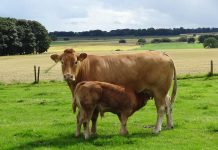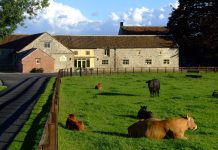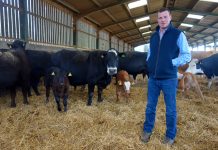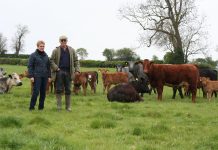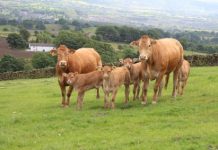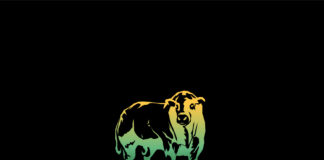Farm feature on the Allison family, Muirburn, near Biggar, Lanarkshire
“With any other breed, you would be struggling to achieve top quality grading for half the animals put forward,” he says. “By contrast, 99 out of 100 Limousins have the potential to achieve a price premium.” Richard and his wife Elizabeth moved to Muirburn, near Biggar, in Lanarkshire, in 1992. They run the farm with their son, Anthony, who has three young children with his partner, Lynn Kerr. Happily, Anthony is also enthusiastic about the Scordale Limousin herd, and takes a keen interest in the pedigree side.
The family’s previous holding in Cumbria was split into a number of different parcels, several of which were as far as 10 miles away from the main steading. The decision to relocate to a 700 acre upland holding within a ring fence has paid off, and the family is now very happy and settled in Scotland. The land at Muirburn stretches from 850 feet to 1,400 feet above sea-level, with the hardy Limousin suckler cows grazing at an average of 1,200 feet.
Before they moved across the border, the Allisons kept around 100 Limousin cross females, as well as a flock of 2,000 ewes. However, a restructuring of the business led to an increase in the size of the suckler herd, at the same time reducing the sheep flock to around 1,000 ewes.
The farm now supports 130 Limousin cows and followers, of which the majority are pedigree. Some three-quarters of the herd calves in spring, with the rest giving birth in the autumn. Heifers are calved at between 2.5 and 3 years old. Meanwhile, finished cattle are sold deadweight at 20-22 months from January until May, with prices recently averaging £1,300 for steers and £1,200 for heifers. All the beef produced is marketed through an arrangement with Dovecote Park, and goes to the Waitrose chain of supermarkets.
“Selling deadweight has made us realise the need for a thick top line,” comments Anthony. “That is the factor that brings in the most U and U+ grades. We used to aim to breed a tall, rangy type of cow, but our policy has changed.
“Bidders at the mart tend to favour muscle on the back end, but when that type of beast is killed out, it may prove to be a disappointment. The extra cash in the back pocket is made on the loin and back, where the most expensive cuts come from. “But if we only select thickset cattle, there is a risk that they will become small and dumpy. Therefore we try to go for a combination of length in the female, and good quality top line muscling in the bull.” Detailed information received from the abattoir on weights and grading has proved particularly useful. To get the best price, cattle need to weigh as near to 400kg as possible; on the grid system used at Dovecote Park, achieving a specification in the mid-three to mid-four range brings in the highest return. A recent Dovecote Park league table of 95 producers saw the Allisons positioned in third place, with 91% of the 84 cattle put forward being graded within the target range.
Another milestone in the Allison’s farming business was in 2002, when the decision was taken to convert to organic production. The move has made relatively little difference to day-to-day farming practices, and having an organic product to sell adds an extra 50p-80p per kg to the grid price, says Richard.
“The main restriction with organic production is that we can’t use concentrate feed to manipulate growth rates. Buying in organic feed would be much too expensive, so we rely on making our own high quality forage instead.”
Veterinary medicines can be used in conjunction with organic livestock production, explains Richard, but only for specific cases and following veterinary advice. Rather than administering a blanket dose of wormer, dung samples are sent away for faecal testing. This allows treatment to be restricted to the animals deemed to be carrying a worm burden high enough to pose a threat to their health and welfare.
The farm grows about 100 acres of organic barley every year, although spring wheat is occasionally used as an alternative. Without the ability to resort to chemicals to tackle plant diseases, the Allisons prefer a spring crop, because it remains in the ground for a shorter period. The barley is fed crimped to the growing cattle, and good use is made of the straw for winter feeding, along with silage.
Two Limousin bulls used in the early days were Uplands Omega and Lumbylaw Salamander. Anthony is particularly interested in pedigree breeding, and as a schoolboy was delighted to be given the Limousin female, Hartside Alexandria, as a Christmas present. Her Uplands Omegasired calf, Scordale Dictator, went on to become overall beef breed champion at Appleby show, and sold for 2,000 guineas at Carlisle.
The Allisons were enthusiastic bidders when Frank Wales dispersed his Limousin herd at Longthwaite Farm, Milburn, Cumbria. Frank had hired Uplands Omega on several occasions, and the chance of buying his female progeny was too good an opportunity to miss.
Other notable bulls include Simbo Danair, bred by Graham Simms of Cheshire. He was purchased following a farm visit, and was already entered for the Royal Show. To the Allison’s delight, Danair took the Junior Breed Championship, which gave them a very proud moment.
Scordale Beefy is a current bull making his mark on the herd. By Goldies Rupert, he is out of Scordale Roulette. Another homebred bull is Scordale Uncanny. Crossdykes Buddha is also expected to be a major influence, and Richard likes his “extreme thickness through the back and loin.” The 2006-born bull by Sarkley Thunderbolt was purchased from James Common of Crossdykes, Lockerbie, for 5,000 guineas.
Limousin cows from the Scordale herd are good doers and often live until well into their teens, says Richard. It is not unusual for a female to produce 10 or more calves during her lifetime, and the excellent conformation of cull cows usually commands a market premium.
Future plans at Muirburn include a gradual increase in cow numbers to 160 head, and a further reduction of the sheep flock. “The sheep market can be very unpredictable. Flock management is labour intensive, and our lambing period clashes with calving. With just the two of us working on the farm, we have to try and arrange the business around an even workload, where possible,” says Richard.
“We feel optimistic about the future. We are always endeavouring to improve our cattle, and the Limousin has given us a head start. All in all, we don’t think the breed will ever be beaten, which is why it has so many loyal followers.”







